Panasonic Lumix DMC-ZS100 Review
Panasonic Lumix DMC-ZS100 Performance - How well does it take pictures?
Choosing a digital camera is all about results: Getting the image quality you need and photographs the way you like them. Travel zooms are designed to be versatile while being highly portable which is why they were designed around small sensors until the ZS100 was introduced.
The Panasonic ZS100 uses a rather large 1" CMOS sensor which appears in Nikon 1 mirrorless cameras and a number of recent premium compacts It provides over 4X the surface area compared to sensors used in previous travel-zooms to deliver significantly better performance, particularly in low-light. The difference between this travel-zoom and premium compacts is that it is equipped with a longer 10X optical zoom rather than a bright aperture. Choosing between these two possibilities is entirely a personal choice.
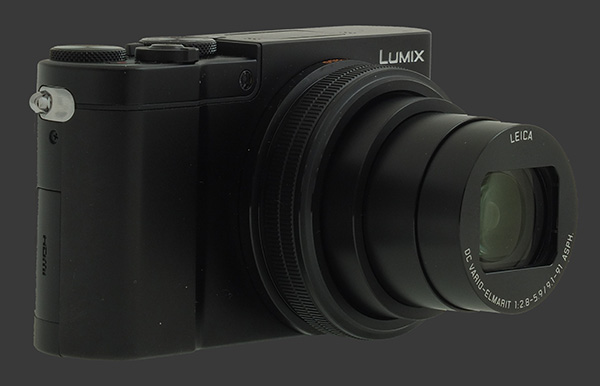
Image quality from this digital camera is good for its size. There is almost no noise from ISO 80 to 125, which is the native sensitivity of the sensor. Details are rendered sharply, provided that the lens is sufficiently stopped down. Dynamic-range and contrast are respectable too. Given a class-leading resolution of 20 megapixels then, the ZS100 can produce very nice large prints, up to 18" x 12" which matches the aspect-ratio of the sensor.
ISO 200 shows an extremely fine noise-pattern which is only visible at 100% magnification. Images remain completely usable even for large prints while maintaining virtually the same dynamic-range and contrast as lower sensitivities. There is a small dip in image quality at ISO 400 which shows more visible noise that affects fine details. Maximum print size is reduced slightly, with 15" x 10" prints easily possible.
Gradually, images lose quality from there on. ISO 800 is a little noisier and shows slightly less details. Medium-sized prints are still possible with good dynamic-range and contrast. ISO 1600 is not much different. It shows more pronounced noise, fewer fine details and a little less dynamic-range. Colors remain quite stable through the entire ISO range which is fantastic.
ISO 3200 is where there is an obvious drop in image quality. While noise-reduction effectively keeps it at bay, it removes small details and greatly lowers image contrast. This can make a passable mid-size print. Small prints though still come out quite nice. ISO 6400 is the limit of useful sensitivities with output which is mostly devoid of details. Small prints come out OK but that is it. ISO 12800 and 25600 should best be avoided as they are both very noise and completely lack detail.
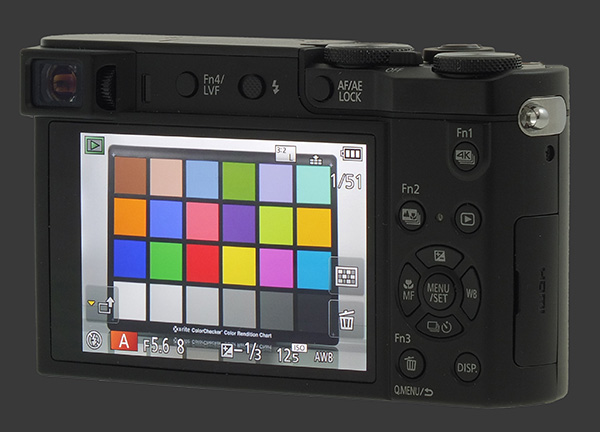
The ZS100 offers a typical set of Color Styles with control over Contrast, Sharpness, Noise-Reduction and Saturation. The default sharpness is somewhat anemic due to a soft lens. By boosting Sharpness to +2, results are much more pleasing despite showing minor sharpening artifacts. Noise-Reduction though is well-balance at its default level.
Colors never get entirely real though. Best results are obtained using Natural style with Saturation at +1. Default Contrast is somewhat dull and improves at +1 without introducing highlight clipping. For more vibrant yet not over-the-top rendering, one can use Standard style with Saturation at -1 instead. Remember that the rear LCD has adjustable colors which helps judge output but not as much as a calibrated computer monitor.
The other part of color rendition is white-balance. The Automatic White-Balance system on the ZS100 performs reasonably well. Under natural light, it provides well-balanced results with no intervention. With artificial lighting though, it gets closer than previous compact Panasonic cameras yet often leaves a slight cast which varies in color. Custom WB works very well though.
Metering is generally reliable with this camera. The Multi-Segment system is tuned to produce bright images while avoiding burning out any sizable area. It can occasionally over-expose to avoid clipping shadows but rarely does so by more than 1/3 EV. Given the sensor has a good dynamic-range, this easily results in usable exposures. For scenes of tremendous contrast, the ZS100 offers built-in HDR capture and AEB of up to 7 frames. The tone-mapping used to render HDR into a standard image is exceptionally well-balanced. Individual frames are automatically aligned which reduces the field-of-view slightly.
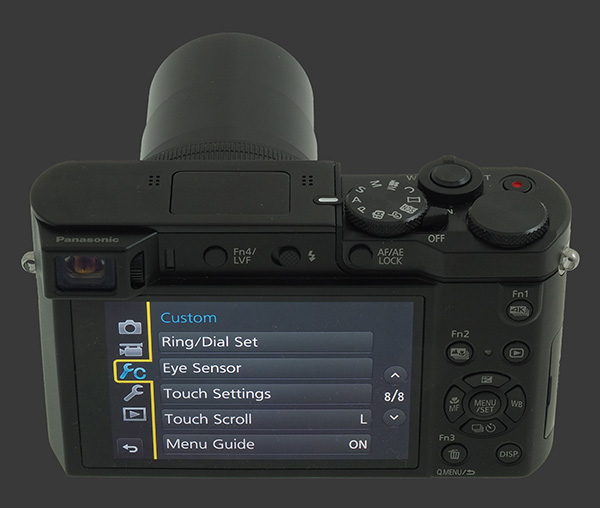
What makes the ZS100 possible is its incredibly compact 25-250mm equivalent lens with a 2.7X crop-factor coverage. The consequence is a maximum aperture which dims down quickly. While it starts at a typical F/2.8, it closes down to F/4 by 46mm and F/5.6 at 122mm with a maximum aperture of F/5.9 starting from 162mm.
The lens is rather soft wide open, although it reaches good sharpness two stops down near wide-angle and one stop down near telephoto. There is significant edge softness which goes deep into the frame at relatively wide apertures. Given that the minimum aperture is F/8 at any focal-length, this does not leave much room for adjustment. F/5.6 to F/8 are generally quite acceptable though.
There is surprisingly little distortion, even at wide-angle. No signs of vignetting or chromatic aberrations either. Lens sharpness is insufficient for such a high-resolution sensor and so must be added by the image processing engine. This produces reasonable results with some sharpening artifacts being visible when viewed at 100%.
This digital camera is nearly always responsive. Except for the upper control-dial which ignores the first click-stop, every other button and dial gets an instant response. Keep in mind though that the control-dial issue could be due to our review unit being pre-production. When shooting continuous bursts, the memory buffer clears rather quickly. Only long bursts may require the user to wait. Even expensive operations such as HDR blending allow the camera to continue operating while processing continues in the background.
For long exposures, the camera optionally employs dark-frame substraction which locks it up for a duration equal to the exposure time. A nice touch is that the ZS100 counts down the exposure time and the dark-frame substraction time, so the photographer knows how much patience is needed.
The performance of this compact digital camera is characterized by the following measurements:
- Power On or Off: 2s. Average for an extending lens camera. Longer if the Lens Resume option is selected.
- Autofocus: As fast as ¼s in moderate to good light yet up to 3s in low-light towards the end of the zoom. Generally between ½ and ¾s though. Extremely variable.
- Zoom: About 3s from widest to longest. On the slow side.
- Image Shutter-Lag: Instant. Excellent.
- Video Shutter-Lag: 1s to start, 2s to stop. Slow.
- Black Out: 1/3s. Good for a fixed-lens camera.
- Shot-to-Shot speed: Just under 1s with AF, ½s in MF mode. Very good.
- Time-to-first shot: 2½s. Good considering most of that time is spend powering on. Longer if the Lens Resume option is selected.
- Playback: About Instant to enter, 1/3s to exit. Good.
This performance is better than average for a travel-zoom and comparable to other premium compacts. Autofocus speed is puzzling which could be a pre-production issue since it is so variable. The ZS100 is certainly capable of focusing very quickly but our unit was prone to hunting in low-light. Shot-to-shoot speeds, particularly in MF mode, are quite impressive. Videographers though will take issue with such slow lag for video.
At 240 shots-per-charge, according to the CIPA measurement standard, battery-life is very short. Even without using the built-in flash, the battery certainly cannot last for a full day of shooting. At least a spare battery is therefore recommended but remember that the camera is incapacitated since it charges internally.
Panasonic Lumix DMC-ZS100 Performance - How well does it shoot video?
Only a handful of compact digital cameras can record 4K video. The Panasonic Lumix DMC-ZS100 is among the select few. It can capture Ultra-HD video at 3840x2160 @ 30 FPS using a 100 Mbps MPEG-4 codec. While there is a large internal buffer, a fast memory card is required to film much over 30s. There is also a higher-quality 24 FPS mode which records fewer frames per second yet uses the same 100 Mbps bandwidth.
While 4K is the headline-grabbing specification, it comes with an important caveat: Recording is done with a 1.48X crop of the sensor. This shifts the lens field-of-view to a decidedly narrow 37-370mm equivalent. On the plus side, this avoids resampling artifacts. Panasonic played attention to this to provide a unique 4K Live-Crop mode which allows the recording area to be moved in real-time.
Ultra-HD video quality is good. Details are well captured and the stream shows little compression artifacts. Motion is relatively smooth too. Metering follows the scene with a progressive adaptation which may temporarily cause over or under exposure while the camera catches up with significant changes in brightness.
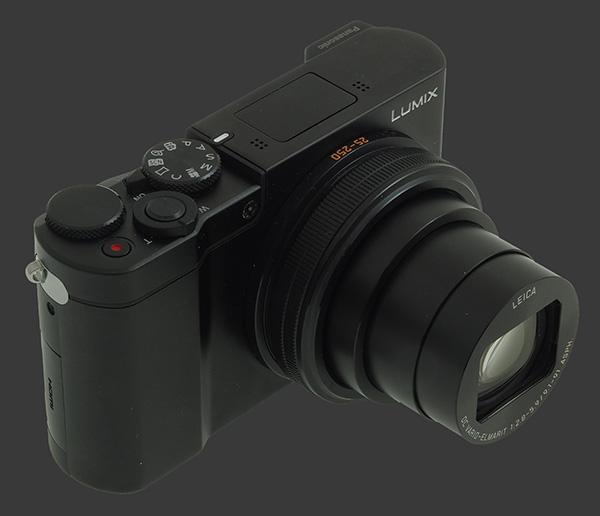
Full 1080p HD video is also possible. At 60 FPS, MPEG-4 uses 28 Mbps and, at 30 FPS, it uses 20 Mbps. Using the AVCHD codec, 1080p is possible at 60 FPS progressive, 60 FPS interlaced, 30 FPS progressive or 24 FPS progressive. 720p and VGA video is also available with MPEG-4.
The full sensor-area is used to record HD video which makes the lens just as versatile as for stills. Video quality is excellent with very smooth motion. The metering system behaves just as it does for 4K video. Zooming and focusing is possible during filming and is nearly inaudible in the audio track.
There is a unique Level-Shot mode which can be enabled at resolutions below 4K. This narrows the field-of-view to 31-310mm which automatically processes a rectangular region of the sensor that rotates to remain level. Our pre-production camera had trouble keeping things level and occasionally tilted a level shot, yet this could be an interesting feature if it is fixed in the final version.
Automatic video can be recorded in any mode by pressing the dedicated Video-Record button. Recording starts after an annoying 1s lag. The same button also stops video recording immediately but it takes another 2 seconds for the camera to become responsive again. Manual exposure is possible in Video mode. All PASM modes are available with the ISO range limited to 6400 and shutter-speed to 1/30s.
Panasonic Lumix DMC-ZS100 Conclusion
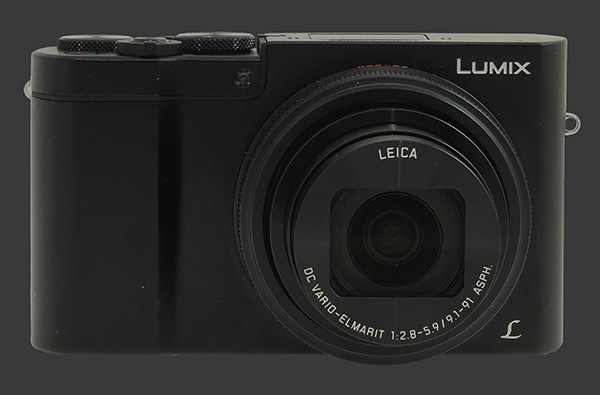
The Panasonic Lumix DMC-ZS100 takes the Travel-Zoom category to the next level by packing a large sensor behind a 10X optical zoom lens while remaining truly compact. Its 20 megapixels 1" CMOS sensor delivers outstanding image quality and performance, in addition to having efficient direct controls, making it the first Premium Travel-Zoom.
Image quality is very good. Noise levels are comparable to modern premium compact which share a similar sensor. Images are completely usable through ISO 400 with up to ISO 1600 being clean enough for mid-sized prints. There is some general softness introduced by the lens which is understandably the necessary compromise to realize such a digital camera. Other than a gradual softening of the edges which is more pronounced at relatively wide apertures, the lens performs rather well with virtually no distortion, no vignetting and no signs of chromatic aberrations.
The 1" CMOS sensor exhibits a nice wide dynamic-range which makes metering easier and quite reliable on the ZS100. Colors and White-Balance are not perfect but generally good. These parameters are highly tunable and there is a RAW mode to fallback on should more accuracy be required. This sensor is also extremely fast with continuous speeds of up to 50 FPS at full-resolution and 4K video capabilities which are nicely integrated into helpful photography features. On the performance side, only autofocus was unusually variable. A delayed response from the Video Record button may concern videographers but has no impact on stills.
The design of the ZS100 is exemplary considering the tight space available for having so many controls on a compact body. Dual control-dials make using the digital camera efficient and a highly customizable interface can put every important feature within easy reach. The EVF which is rarely seen on such small cameras is tiny and low-resolution, so it is helpful for composition and stability but not entirely comfortable and too coarse to judge focus. The rear LCD though is fantastic with good visibility, sharpness and a fast refresh rate.
All this makes the ZS100 the travel-zoom of choice. It delivers exactly as it should: Solid image quality with a long zoom in a compact body. Realizing this digital camera is about choosing a set of compromises that fits and Panasonic managed brilliantly. They had to leave softness in the lens and use a tiny EVF - still with an extremely useful Eye-Start sensor! - but this produced a unique travel-zoom with a large sensor.
 |
Please Support Neocamera
All information on Neocamera is provided free of charge yet running this website is a huge endeavor. Purchases made via affiliate links found throughout the site help keep it running and up-to-date. There is no additional cost to you, so please consider buying via these links to our affilates:
If you found any information on this site valuable and did not purchase via our affiliate links, please considering donating via PayPal:
Any amount will be greatly appreaciated. Thank you for your support!
Panasonic DMC-ZS100 Highlights

Sensor-Size: 13 x 9mm

Actual size when viewed at 100 DPI
| 20 Megapixels Travel Zoom | ISO 125-12800 |
| 10X Ultra-Wide Optical Zoom | Shutter 1/16000-60s |
| Built-in Stabilization | Full manual controls, including Manual Focus |
| 0.20" Built-in EVF 120K Pixels (0.46X) | Custom white-balance with 2 axis fine-tuning |
| Automatic Eye-Start sensor | Spot-Metering |
| Auto Horizon Correction 2 Axis Digital Level | Lithium-Ion Battery |
| 50 FPS Drive, Unlimited Images | Secure Digital Extended Capacity |
| 3840x2160 @ 30 FPS Video Recording | |
| 3" LCD 1 Megapixels |
Updates
2024.08.07

Eye Protection Tips for Professional Photographers
The four main considerations for professional photographers regarding eyewear.
2024.07.14

Fujifilm X100VI Review
Flagship fixed-lens compact digital camera with a 40 MP sensor and Image-Stabilization, a first for the series. Retro design featuring dual control-dials, plus direct ISO, Shutter-Speed and EC dials. Its hybrid viewfinder can switch between EVF and OVF mode.
2024.05.09

Fujifilm GFX100 II Review
Flagship 102 Megapixels Medium-Format Mirrorless Digital Camera with 8-Stop 5-Axis IBIS, 8 FPS Drive, 8K Video and 400 MP Super-Resolution capture in a weatherproof and freezeproof body with dual control-dials and dual memory-card slots.
2024.04.03

Fujifilm X-T5 Review
Newest Fujifilm flagship boasting a 40 MP APS-C sensor, 5-axis IBIS with 7-stop efficiency, 15 FPS continuous drive, 6.2K Video capture, dual control-dials and dual SDXC UHS-II slots in a sturdy weatherproof and freezeproof body.
2023.11.20

Best Digital Cameras of 2023
Find out which are the Best Digital Cameras of 2023. All the new Mirrorless Digital Cameras from entry-level to high-end professional.
2023.07.10

Fujifilm X-H2 Review
40 Megapixels APS-C Hybrid Mirrorless Digital Camera with 7-stop IBIS. Fastest shutter ever and 8K video capture. Large builtin EVF with 0.8X magnification and 5.8 MP, plus an Eye-Start Sensor. Packed with features and large number of controls in a weatherproof and freezeproof body.
2023.05.07

Sony FE 20-70mm F/4G Review
Review of the unique Sony FE 20-70mm F/4G lens. The optical zoom of this lens spans ultra-wide-angle and medium focal-length coverage, making it one of the most versatile Full-Frame lenses on the market.
2023.01.15

Huion Inspiroy Dial 2 Review
Review of the Huion Inspiroy Dial 2 tablet, a medium sized drawing surface with dual dials and customizable buttons. Connects via USB-C or Bluetooth 5.0 with Windows, Linux and Android support.
2022.12.08

How to Pack for a Photo Trip
Find out how to pack for a travel photography trip, carry your gear safely while meeting airline regulations.
2022.11.13

Best Digital Cameras of 2022
The best digital cameras of 2022. A short list of the most outstanding models in their respective categories. Choose one for yourself or as a gift.
2022.09.21

Pentax DA* 60-250mm F/4 SDM Review
Review of the Pentax DA* 60-250mm F/4 SDM, the constant-aperture telephoto zoom with the highest zoom-ratio on the market.
2022.09.20

Pentax DA* 50-135mm F/2.8 SDM Review
Review of the Pentax DA* 50-135mm F/2.8 SDM, the lightest professional telephoto zoom native to the K-mount.












